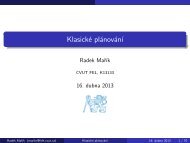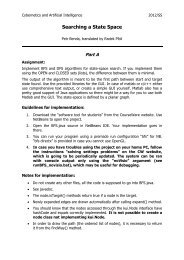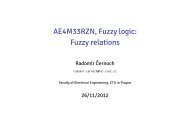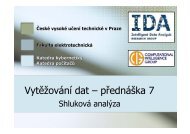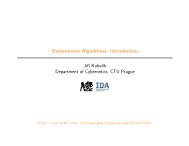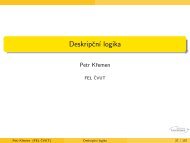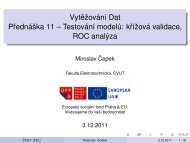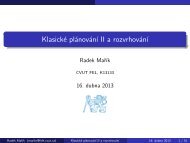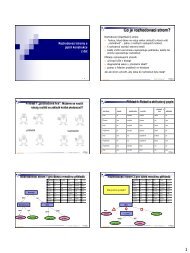RANSAC [Fischler, Bolles '81]
RANSAC [Fischler, Bolles '81]
RANSAC [Fischler, Bolles '81]
You also want an ePaper? Increase the reach of your titles
YUMPU automatically turns print PDFs into web optimized ePapers that Google loves.
<strong>RANSAC</strong><br />
Robust model estimation from data<br />
contaminated by outliers<br />
Ondřej Chum and Jiří Matas
Fitting a Line<br />
Least squares fit
<strong>RANSAC</strong><br />
• Select sample of m points<br />
at random
<strong>RANSAC</strong><br />
• Select sample of m points at<br />
random<br />
• Calculate model<br />
parameters that fit the data<br />
in the sample
<strong>RANSAC</strong><br />
• Select sample of m points at<br />
random<br />
• Calculate model parameters<br />
that fit the data in the sample<br />
• Calculate error function<br />
for each data point
<strong>RANSAC</strong><br />
• Select sample of m points at<br />
random<br />
• Calculate model parameters<br />
that fit the data in the sample<br />
• Calculate error function for<br />
each data point<br />
• Select data that support<br />
current hypothesis
<strong>RANSAC</strong><br />
• Select sample of m points at<br />
random<br />
• Calculate model parameters<br />
that fit the data in the sample<br />
• Calculate error function for<br />
each data point<br />
• Select data that support<br />
current hypothesis<br />
• Repeat sampling
<strong>RANSAC</strong><br />
• Select sample of m points at<br />
random<br />
• Calculate model parameters<br />
that fit the data in the sample<br />
• Calculate error function for<br />
each data point<br />
• Select data that support<br />
current hypothesis<br />
• Repeat sampling
How Many Samples?<br />
On average<br />
N … number of point<br />
I … number of inliers<br />
m … size of the sample<br />
P(good) =<br />
mean time before the success<br />
E(k) = 1 / P(good)
How Many Samples?<br />
With confidence p
How Many Samples?<br />
P(good) =<br />
With confidence p<br />
N … number of point<br />
I … number of inliers<br />
m … size of the sample<br />
P(bad) = 1 – P(good)<br />
P(bad k times) = (1 – P(good)) k
How Many Samples?<br />
With confidence p<br />
P(bad k times) = (1 – P(good)) k ≤ 1 - p<br />
k log (1 – P(good)) ≤ log(1 – p)<br />
k ≥ log(1 – p) / log (1 – P(good))
Size of the sample m<br />
How Many Samples<br />
I / N [%]
<strong>RANSAC</strong><br />
k =<br />
log(1 – p)<br />
I I-1<br />
log (1- )<br />
k … number of samples<br />
drawn<br />
N … number of data points<br />
I … time to compute a<br />
single model<br />
p … confidence in the<br />
solution (.95)<br />
N<br />
N-1
<strong>RANSAC</strong> [<strong>Fischler</strong>, <strong>Bolles</strong> ’81]<br />
In: U = {x i} set of data points, |U| = N<br />
function f computes model parameters p given a sample S from U<br />
the cost function for a single data point x<br />
Out: p * p * , parameters of the model maximizing the cost function<br />
k := 0<br />
Repeat until P{better solution exists} < η (a function of C * and no. of steps k)<br />
k := k + 1<br />
I. Hypothesis<br />
(1) select randomly set , sample size<br />
(2) compute parameters<br />
II. Verification<br />
(3) compute cost<br />
(4) if C * < C k then C * := C k, p * := p k<br />
end<br />
(III. Is the solution valid?)
<strong>RANSAC</strong> Issues:<br />
<strong>RANSAC</strong> is a very general robust estimation method, any problems?<br />
- Correctness of the results. Degeneracy.<br />
Solution: DegenSAC.<br />
- Stopping criterion?:<br />
Repeat until<br />
P{better solution exists} < η (a function of C * and no. of steps k)<br />
- Cost function:<br />
Solutions: Least median of Squares, MINPRAN<br />
- Accuracy (model parameters are estimated from minimal samples):<br />
Solution: Locally Optimized <strong>RANSAC</strong><br />
- Speed:<br />
Running time grows with<br />
1. number of data points,<br />
2. number of iterations (polynomial in inlier ratio)<br />
Addressing the problem:<br />
<strong>RANSAC</strong> with SPRT (WaldSAC), PROSAC
J. Matas, O. Chum,<br />
25<strong>RANSAC</strong> workshop CVPR<br />
2006 éž<br />
<strong>RANSAC</strong> – Time Complexity<br />
Repeat k times (k is a function of η, Ι, Ν)<br />
1. Hypothesis generation<br />
• Select a sample of m data points<br />
• Calculate parameters of the model(s)<br />
2. Model verification<br />
• Find the support (consensus set) by<br />
• verifying all N data points<br />
I–- the number of inliers<br />
N - the number of data points<br />
η − confidence in the solution<br />
Time<br />
Total running time:<br />
Center for Machine<br />
Perception Prague<br />
WaldSAC - Optimal Randomised <strong>RANSAC</strong> 17
J. Matas, O. Chum,<br />
25<strong>RANSAC</strong> workshop CVPR<br />
2006 éž<br />
<strong>RANSAC</strong> time complexity<br />
where P is a probability of drawing an all-inlier sample<br />
where m is size of the sample<br />
Center for Machine<br />
Perception Prague<br />
WaldSAC - Optimal Randomised <strong>RANSAC</strong> 18
J. Matas, O. Chum,<br />
25<strong>RANSAC</strong> workshop CVPR<br />
2006 éž<br />
Randomised <strong>RANSAC</strong> [Matas, Chum 02]<br />
Repeat k/(1-α) times<br />
1. Hypothesis generation<br />
2. Model pre-verification T d,d test<br />
• Verify d
J. Matas, O. Chum,<br />
25<strong>RANSAC</strong> workshop CVPR<br />
2006 éž<br />
Optimal Randomised Strategy<br />
Model Verification is Sequential Decision Making<br />
where<br />
H g - hypothesis of a `good` model (≈ from an uncontaminated sample)<br />
H b - hypothesis of a `bad` model, (≈ from a contaminated sample)<br />
δ - probability of a data point being consistent with an arbitrary model<br />
Center for Machine<br />
Perception Prague<br />
Optimal (the fastest) test that ensures with probability α that that H g is<br />
not incorrectly rejected<br />
is the<br />
Sequential probability ratio test (SPRT) [Wald47]<br />
WaldSAC - Optimal Randomised <strong>RANSAC</strong> 20
J. Matas, O. Chum,<br />
25<strong>RANSAC</strong> workshop CVPR<br />
2006 éž<br />
SPRT [simplified from Wald 47]<br />
Compute the likelihood ratio<br />
Two important properties of SPRT:<br />
1. probability of rejecting a \good\ model α < 1/A<br />
2. average number of verifications V=C log(A)<br />
Center for Machine<br />
Perception Prague<br />
WaldSAC - Optimal Randomised <strong>RANSAC</strong> 21
J. Matas, O. Chum,<br />
25<strong>RANSAC</strong> workshop CVPR<br />
2006 éž<br />
SPRT properties<br />
1. Probability of rejecting a \good\ model α=1/A<br />
Center for Machine<br />
Perception Prague<br />
WaldSAC - Optimal Randomised <strong>RANSAC</strong> 22
J. Matas, O. Chum,<br />
25<strong>RANSAC</strong> workshop CVPR<br />
2006 éž<br />
WaldSAC<br />
Repeat k/(1-1/A) times<br />
1. Hypothesis generation<br />
2. Model verification<br />
use SPRT<br />
Time<br />
In sequential statistical decision problem decision errors are traded off for time.<br />
These are two incomparable quantities, hence the constrained optimization.<br />
In WaldSAC, decision errors cost time (more samples) and there is a single<br />
minimised quantity, time t(A), a function of a single parameter A.<br />
Center for Machine<br />
Perception Prague<br />
WaldSAC - Optimal Randomised <strong>RANSAC</strong> 23
J. Matas, O. Chum,<br />
25<strong>RANSAC</strong> workshop CVPR<br />
2006 éž<br />
Optimal test (optimal A) given ε and δ<br />
Optimal A *<br />
Optimal A * found by solving<br />
Center for Machine<br />
Perception Prague<br />
WaldSAC - Optimal Randomised <strong>RANSAC</strong> 24
J. Matas, O. Chum,<br />
25<strong>RANSAC</strong> workshop CVPR<br />
2006 éž<br />
decision<br />
bad model<br />
SPRT<br />
good model<br />
Center for Machine<br />
Perception Prague<br />
WaldSAC - Optimal Randomised <strong>RANSAC</strong> 25
J. Matas, O. Chum,<br />
25<strong>RANSAC</strong> workshop CVPR<br />
2006 éž<br />
Exp. 1: Wide-baseline matching<br />
Center for Machine<br />
Perception Prague<br />
WaldSAC - Optimal Randomised <strong>RANSAC</strong> 26
J. Matas, O. Chum,<br />
25<strong>RANSAC</strong> workshop CVPR<br />
2006 éž<br />
Exp. 2 Narrow-baseline stereo<br />
Center for Machine<br />
Perception Prague<br />
WaldSAC - Optimal Randomised <strong>RANSAC</strong> 27
J. Matas, O. Chum,<br />
25<strong>RANSAC</strong> workshop CVPR<br />
2006 éž<br />
Randomised Verification in <strong>RANSAC</strong>:<br />
Conclusions<br />
The same confidence η in the solution reached faster (data dependent, ¼<br />
10x)<br />
No change in the character of the algorithm, it was randomised anyway.<br />
Optimal strategy derived using Wald`s theory for known ε and δ.<br />
Results with ε and δ estimated during the course of <strong>RANSAC</strong> are not<br />
significantly different. Performance of SPRT is insensitive to errors in the<br />
estimate.<br />
• δ can be learnt, an initial estimate can be obtained by geometric<br />
consideration<br />
• Lower bound on ε is given by the best-so-far support<br />
• Note that the properties of WaldSAC are quite different from preemptive<br />
<strong>RANSAC</strong>!<br />
Center for Machine<br />
Perception Prague<br />
WaldSAC - Optimal Randomised <strong>RANSAC</strong> 28
PROSAC – PROgressive SAmple Consensus<br />
• Not all correspondences are created equally<br />
• Some are better than others<br />
• Sample from the best candidates first<br />
1 2 3 4 5 … N-2 N-1 N<br />
Sample from here
…<br />
Draw T l samples from (1 … l)<br />
Draw T l+1 samples from (1 … l+1)<br />
PROSAC Samples<br />
l-1 l l+1 l+2 …<br />
Samples from (1 … l) that are not from (1 … l+1) contain l+1<br />
Draw T l+1 - T l samples of size m-1 and add l+1
J. Matas, O. Chum,<br />
25<strong>RANSAC</strong> workshop CVPR<br />
2006 éž Locally<br />
Optimized <strong>RANSAC</strong><br />
Chum, Matas, Kittler: Locally Optimized <strong>RANSAC</strong>, DAGM 2003<br />
Center for Machine<br />
Perception Prague<br />
It was observed experimentally, that <strong>RANSAC</strong> takes several times<br />
longer than theoretically expected. This is due to the noise on inlier<br />
measurement – not every all-inlier sample generates a good hypothesis.<br />
By applying local optimization (LO) to the-best-so-far hypotheses:<br />
(i) a near perfect agreement with theoretical (i.e. optimal) performance<br />
(ii) lower sensitivity to noise and poor conditioning.<br />
The LO is shown to be executed so rarely that it has minimal impact on<br />
the execution time.
J. Matas, O. Chum,<br />
25<strong>RANSAC</strong> workshop CVPR<br />
2006 éž Locally<br />
Optimized <strong>RANSAC</strong><br />
Center for Machine<br />
Perception Prague<br />
Estimation of (approximate) models with lower complexity (less data<br />
points in the sample) followed by LO step estimating the desired model<br />
speeds the estimation up significantly.<br />
The estimation of epipolar geometry is up to 10000 times<br />
faster when using 3 region-to-region correspondences rather<br />
than 7 point-to-point correspondences.<br />
Fish-eye images by Braňo Mičušík<br />
Simultaneous estimation of radial distortion<br />
and epipolar geometry with LO is superior to<br />
the state-of the art in both speed a precision of<br />
the model.<br />
Chum, Matas, Obdržálek: Enhancing <strong>RANSAC</strong> by Generalized Model Optimization,<br />
ACCV 2004
J. Matas, O. Chum,<br />
25<strong>RANSAC</strong> workshop CVPR<br />
2006 éž<br />
Degenerate Configurations<br />
The presence of degenerate configuration causes <strong>RANSAC</strong> to fail in<br />
estimating a correct model, instead a model consistent with the<br />
degenerate configuration and some outliers is found.<br />
The DEGENSAC algorithm handles<br />
scenes with:<br />
• all points in a single plane<br />
• majority of the points in a single<br />
plane and the rest off the plane<br />
• no dominant plane present<br />
No a-priori knowledge of the type of<br />
the scene is required<br />
Center for Machine<br />
Perception Prague<br />
Chum, Werner, Matas: Epipolar Geometry Estimation unaffected by dominant plane,<br />
CVPR 2005
J. Matas, O. Chum,<br />
25<strong>RANSAC</strong> workshop CVPR<br />
2006 éž<br />
Center for Machine<br />
Perception Prague


![RANSAC [Fischler, Bolles '81]](https://img.yumpu.com/17549294/1/500x640/ransac-fischler-bolles-81.jpg)
